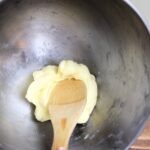Butter has been a kitchen staple for centuries, prized for its rich, creamy taste and its versatility in cooking, baking, and spreading on bread. But before butter was mass-produced and packaged in stores, people made it at home straight from fresh milk. Today, many want to return to those traditional methods, not just for the nostalgia but also to control quality and enjoy the natural flavors of farm-fresh dairy How do you make butter from raw milk.
If you’ve ever asked yourself how to make butter from raw milk or wondered if it’s possible to churn your own golden spread with minimal equipment, you’re in the right place. This comprehensive beginner’s guide walks you through the process, explaining everything from separating cream to churning butter, and even where to buy raw butter if making your own feels overwhelming.
Why Raw Milk for Homemade Butter?
Raw milk is milk that hasn’t been pasteurized or homogenized. Unlike store-bought varieties, raw milk is full of natural enzymes, beneficial bacteria, and cream that naturally rises to the top. When making butter, this cream is the essential ingredient.
Some of the main advantages of using raw milk include:
-
Rich and natural flavor
-
Higher nutrient content (vitamins A, D, E, and K2)
-
Beneficial probiotics for gut health
-
Traditional authenticity—exactly how butter was made for generations
However, it’s important to ensure your raw milk comes from a trusted, hygienic, and grass-fed source. If you’re unsure about your supplier, always prioritize safety.
Step 1: Skim the Cream
The first step in how to make raw milk butter is separating the cream from the milk. This can be done easily:
-
Set the milk aside – Pour your raw milk into a wide glass jar or container. Leave it in the refrigerator for 12–24 hours.
-
Wait for the cream to rise – Cream is less dense than milk, so it will naturally float to the top, forming a thick, creamy layer.
-
Skim the cream off – Use a spoon or ladle to carefully scoop the cream into another jar. This is the base of your butter.
Tip: The fresher the milk, the easier it is to separate the cream. You’ll need about two cups of cream to make one cup of butter.
Step 2: Let the Cream Rest
Before churning, many traditional butter makers recommend letting the cream “ripen” for a few hours at room temperature. This makes it easier for the butterfat to separate and enhances flavor. If you prefer sweet cream butter (milder in taste), skip this step and churn the cream right after skimming.
Step 3: Churn the Cream
Churning cream into butter is the most exciting step in this process. Here are some popular methods:
-
Mason jar method: Pour your cream into a large mason jar, seal it, and shake vigorously for 10–15 minutes. First, you’ll get whipped cream, and after a while, you’ll hear clumps of butter forming.
-
Stand mixer or blender: Pour your cream into the mixing bowl and beat on medium-high. The cream will go from liquid to whipped cream, and then suddenly, yellow butter clumps will form, separating from the buttermilk.
-
Traditional churn: If you have an old-fashioned butter churn, simply pour your cream inside and churn with steady effort until butter forms.
This is the moment you’ll finally see the pale yellow lumps of butter floating in liquid buttermilk—it’s a magical transformation!
Step 4: Wash the Butter
One of the most critical but often overlooked steps in how to make butter with raw milk is washing. Unwashed butter spoils quickly.
-
Strain the butter lumps out of the buttermilk using a strainer.
-
Rinse the butter under cold water while kneading it with a spatula or your hands. Keep rinsing until the water runs clear.
-
Optional: Add a pinch of salt to preserve the butter and enhance flavor.
Step 5: Store and Use Your Butter
Fresh raw milk butter can be refrigerated for up to a week or frozen for longer storage. Homemade butter is perfect for:
-
Spreading on fresh bread
-
Cooking (especially sautéing vegetables or meats)
-
Baking cookies, pies, and cakes
-
Making herb or garlic butter for savory dishes
And don’t throw away the leftover buttermilk! It can be used in pancakes, biscuits, or even as a base for cultured fermented foods.
Benefits of Making Your Own Raw Butter
-
Control and quality: You know exactly what goes into your butter—no additives or preservatives.
-
Cost savings: If you regularly buy raw milk, making butter at home can be economical.
-
Sustainability: Homemade butter reduces plastic packaging from store-bought options.
-
Healthier choice: Raw butter retains beneficial enzymes and nutrients compared to processed alternatives.
Common Mistakes to Avoid
-
Using ultra-pasteurized milk: Store-bought milk processed this way will not allow cream separation.
-
Not washing the butter well: Residual buttermilk reduces shelf life and can cause spoilage.
-
Churning too long: Overchurning into very small grains makes washing harder.
-
Skipping refrigeration before skimming: Cream rises much more cleanly when raw milk rests in the fridge overnight.
Where to Buy Raw Butter
If you don’t have access to raw milk or prefer not to make it yourself, you may wonder where to buy raw butter. Many small farms, local dairies, and farmers’ markets sell raw butter directly. In some states or countries, raw dairy products are sold legally in health food stores.
However, always check local laws—raw butter is not legal everywhere due to food safety regulations. For reliable information, you can check the Raw Milk Institute which lists certified safe raw milk and butter suppliers.
Frequently Asked Questions
1. How do you make butter from raw milk at home without a churn?
You can use a blender, mixer, or even shake cream in a glass jar until it separates into butter and buttermilk.
2. Is butter from raw milk safe?
When made from hygienic, high-quality milk sourced from grass-fed cows, it is safe for most people. Always work with clean utensils and store butter properly.
3. How much butter does one gallon of raw milk produce?
On average, one gallon of raw milk yields about one pint of cream, which can make half a cup to one cup of butter.
4. Can I flavor my homemade butter?
Yes! You can blend in herbs, garlic, or honey after churning to make flavored spreads.
Read More: How to Make Raw Milk Butter: The Old-Fashioned Way
Conclusion
Learning how to make butter from raw milk isn’t just a fun project—it’s a step back into traditional food-making, connecting you to the way our grandparents and ancestors enjoyed dairy. Whether you’re skimming cream off farm-fresh milk or curious about how to make butter with raw milk using modern blenders, the process is surprisingly straightforward.
And if you prefer to skip the DIY effort, you can always research where to buy raw butter from local dairies or trusted farms. Either way, the reward is fresh, creamy, nutrient-rich butter that tastes far better than most store-bought versions.
So next time someone asks how do you make butter from raw milk, you’ll not only be able to explain the process but also whip up a golden pat of homemade goodness to share.









